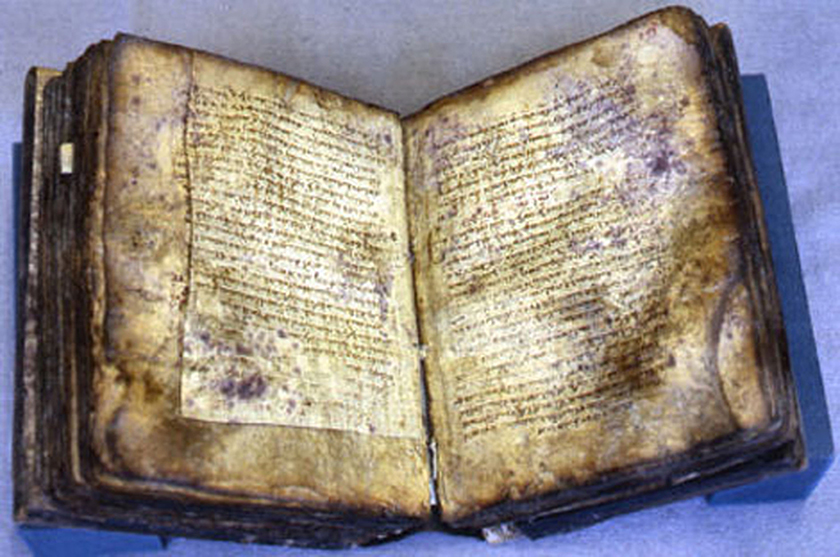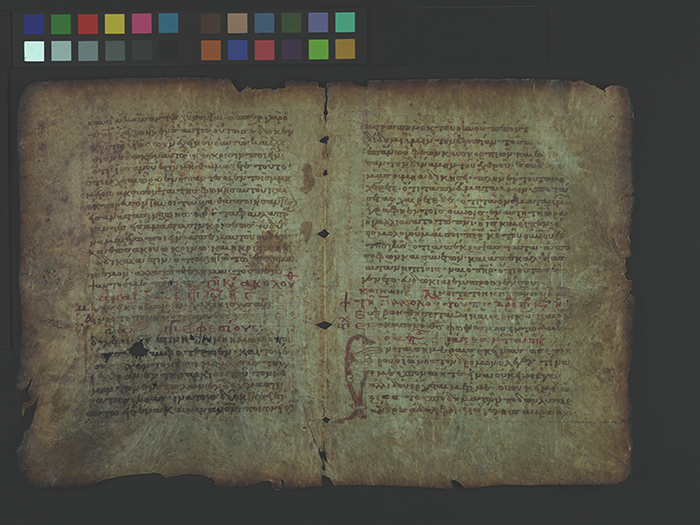- About MAA
- Membership
- MAA Publications
- Periodicals
- Blogs
- MAA Book Series
- MAA Press (an imprint of the AMS)
- MAA Notes
- MAA Reviews
- Mathematical Communication
- Information for Libraries
- Author Resources
- Advertise with MAA
- Meetings
- Competitions
- Programs
- Communities
- MAA Sections
- SIGMAA
- MAA Connect
- Students
- MAA Awards
- Awards Booklets
- Writing Awards
- Teaching Awards
- Service Awards
- Research Awards
- Lecture Awards
- Putnam Competition Individual and Team Winners
- D. E. Shaw Group AMC 8 Awards & Certificates
- Maryam Mirzakhani AMC 10 A Awards & Certificates
- Two Sigma AMC 10 B Awards & Certificates
- Jane Street AMC 12 A Awards & Certificates
- Akamai AMC 12 B Awards & Certificates
- High School Teachers
- News
You are here
Mathematical Treasure: The Archimedes Palimpsest
In 1906 the Danish philologist Johan Ludvig Heiberg learned of the existence of a mathematical palimpsest in a Greek Orthodox monastery library in Constantinople. The palimpsest was in the form of a prayer book written in the thirteenth century. Its pages were recycled vellum, scraped and washed to remove past writings; such previously used and erased pages are referred to as palimpsest. Employing the best photographic and magnification technology of his time, Heiberg undertook the challenge of deciphering the underlying writing. To his amazement and delight he revealed several Archimedean treatises composed in the tenth century, making them the oldest such works in existence. He eventually found seven of these treasures: On the Sphere and Cylinder, On Spirals, Measurement of a Circle, Equilibrium of Planes, On Floating Bodies, and, most importantly, copies of The Method and Stomachion, two treatises known to have been composed by Archimedes but for which copies had long since been lost.
Soon after Heiberg’s encounter with the Archimedes Palimpsest, it disappeared. It eventually reappeared in 1998 at an auction of antiquities, where it was purchased by an anonymous bidder. Soon afterwards, the new owner entrusted the palimpsest to the Walters Museum in Baltimore, Maryland, as an object to be conserved and researched. To serve the purposes of conservation and research, the Archimedes Palimpsest Project was established and has functioned for over twelve years. The results of the Project’s work, in terms of images and translations, are available at the Project website.
In cooperation with the Walters Museum and the Archimedes Palimpsest Project, Convergence is pleased to present the following series of images.

Figure 1. The Greek prayer book and hymnal as it existed in 1998 in a dangerous state of neglect and deterioration. (Photo courtesy of Walters Museum, Baltimore, Maryland)

Figure 2. Two pages of the prayer book in natural light. (Photo courtesy of Walters Museum, Baltimore, Maryland)

Figure 3. A close-up view of the lower center region of the same two-page spread of the open book. At left center in this image can be discerned a diagram of a spiral. (Photo courtesy of Walters Museum, Baltimore, Maryland)

Figure 4. This spiral viewed under a blue light filter revealing more detail. Note the precision with which the spiral is drawn, remembering it was done in the 10th century with a quill pen. (Photo courtesy of Walters Museum, Baltimore, Maryland)

Figure 5. A negative image of the same two pages of the open book. Such an image is called a “pseudo sharpie” in the technical language of image extraction. Here, the image of the spiral stands out clearly. (Photo courtesy of Walters Museum, Baltimore, Maryland)

Figure 6. Another “pseudo sharpie” of the same pages, perhaps using different light filters, reveals a second diagram at upper right of the lefthand page. (Photo courtesy of Walters Museum, Baltimore, Maryland)
It seems that the two pages shown in Figures 2-6 are from Archimedes’ On Spirals and more specifically concern Propositions 18 and 19 [1, p. 171]:
If OA be the initial line, A the end of the first turn of the spiral, and if the tangent to the spiral at A be drawn, the straight line OB drawn from O perpendicular to OA will meet the said tangent in some point B, and OB will be equal to the circumference of the ‘first circle.’
Reference
[1] T. L. Heath (editor), The Works of Archimedes, Vol. I, Dover Publications, 2002. Originally published by Cambridge University Press in 1897.
Frank J. Swetz (The Pennsylvania State University), "Mathematical Treasure: The Archimedes Palimpsest," Convergence (July 2013)




